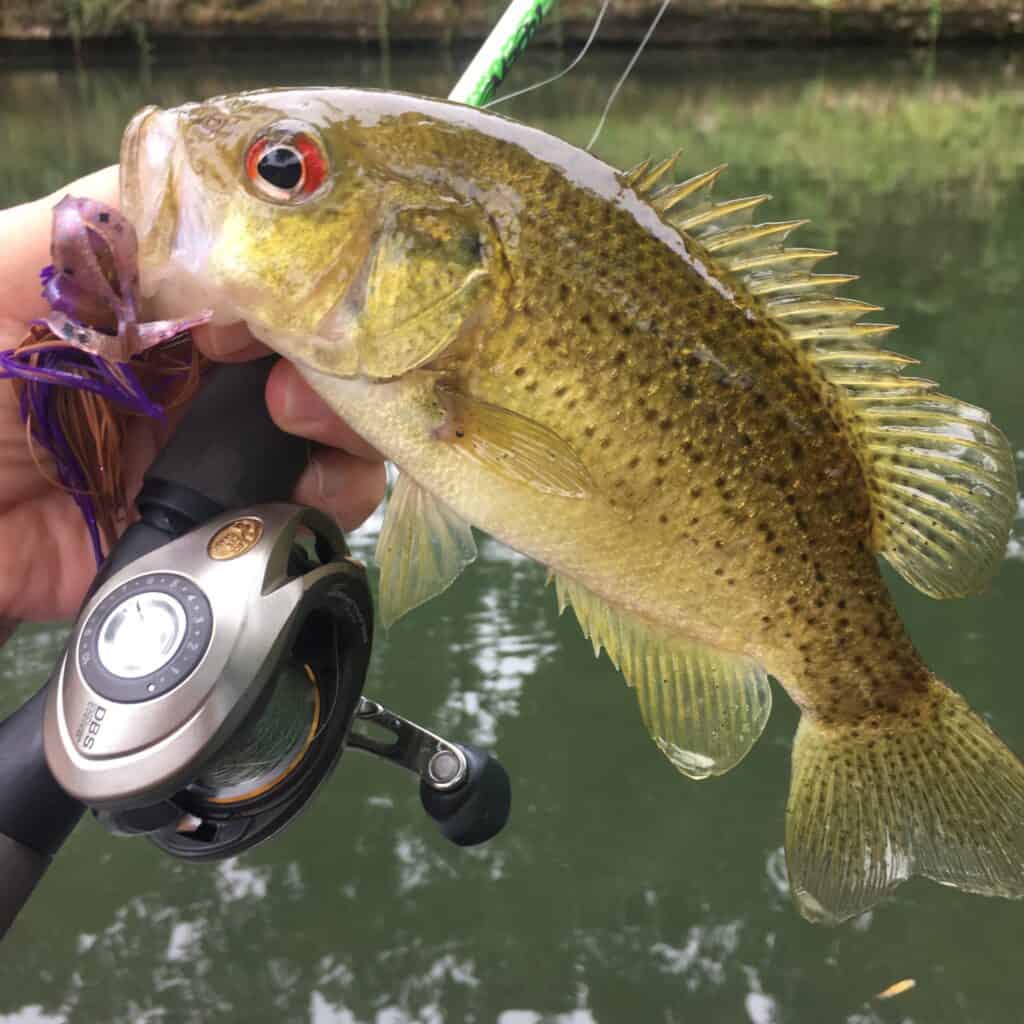Ozark Bass
Ambloplites constellatus
Ozark Bass only live in Arkansas and Missouri
Advertisement
Ozark Bass Scientific Classification
- Kingdom
- Animalia
- Phylum
- Chordata
- Class
- Actinopterygii
- Order
- Perciformes
- Family
- Centrarchidae
- Genus
- Ambloplites
- Scientific Name
- Ambloplites constellatus
Read our Complete Guide to Classification of Animals.
Ozark Bass Conservation Status
Ozark Bass Facts
- Prey
- Minnows, crayfish, and insects
- Main Prey
- Crayfish
- Name Of Young
- Fly
- Fun Fact
- Ozark Bass only live in Arkansas and Missouri
- Biggest Threat
- Habitat loss and water contamination
- Most Distinctive Feature
- Large red eyes
- Other Name(s)
- Goggle-eye
- Diet
- Omnivore
- Favorite Food
- Crayfish
- Type
- Sunfish
- Common Name
- Ozark Bass
- Origin
- Arkansas and Missouri
- Location
- Arkansas and Missouri
View all of the Ozark Bass images!
“Ozark bass only inhabit the tributaries of White River, and very little is known about them.”
Summary
Native to White River tributaries in Arkansas and Missouri, Ozark bass populations do not reach far. The fish species is unique in that they cannot be found anywhere else in the United States. Their concentrated population has not turned away fishing, though. In fact, fishing for Ozark bass is popular and enjoyable in the White River region. This species comes in all shapes, sizes, and variations, ranging from 3.5 ounces to one pound in weight. Therefore, catching this fish will always lead to a surprise. Furthermore, this bass, also known as “goggle-eye,” has large red eyes, giving it a unique appearance.
8 Ozark Bass Facts
- The largest Ozark bass ever caught weighed one pound, which is over 12 ounces greater than their average weight!
- They were originally thought to be the same species as the redeye bass.
- Very little is known about this fish, including population numbers, mating patterns, and natural predators.
- Their favorite food is crayfish.
- Threats to Ozark bass include habitat loss, water contamination, gravel mining, illness, lack of food, and varying water levels and temperatures due to climate change.
- They can live up to six years.
- Males build and guard the nests, rather than females.
- Ozark bass prefer plentiful amounts of shade and cool water temperatures.
Classification and Scientific Name
The scientific name of the Ozark bass is Ambloplites constellatus. However, people that live near their habitat refer to this species as “goggle-eye.” This bass belongs to the Centrarchidae, or sunfish, family and the Teleostei class. It was classified as its own species when researchers distinguished it from the redeye bass, whose scientific name is Ambloplites rupestis. Beforehand, many assumed that these two species were the same. The term Ambloplites comes from the Greek words ambloo, meaning blunt, and oplites, meaning shield.
Ozark Bass Appearance
Ozark bass have a maximum length of 10.98 inches and an average length of 5.24 inches. It takes approximately five years for this fish to achieve 8 inches in length. The maximum reported weight of an Ozark bass is one pound. The average female length measured 6.50 inches when recorded by researchers in the Buffalo River region, and the average male length in the same area measured 6.65 inches. Weights recorded at the Buffalo River averaged 3.69 ounces for female bass and 3.88 ounces for males. These figures follow the same trends as those recorded at Crooked Creek on the White River.
The Ozark bass is a slimmer kind of rock bass. Its eyes are large and red, which is likely why they were previously confused for redeye bass. Its body coloration is a mix of brown and green shades and includes various little black specks, which are randomly distributed across the body.

The Ozark bass is brown and green with little black specks and has red eyes.
Distribution, Population, and Habitat
Populations are extremely condensed. In fact, they can only be found in the upper portion of the White River drainage in Missouri and Arkansas in the United States. While efforts have been made to create populations of them in other areas, they have not proved to be successful.
These bass can be encountered in creeks, streams, and small to medium-sized rivers. They prefer waters with increased dissolved oxygen levels, little to no turbidity, and an abundance of plant species. They enjoy being near rocks, wood, or brush and alongside the banks of a river or stream.
Unfortunately, there are very few estimates of Ozark bass present in the White River region. Therefore, a general population count has not been recorded. However, some studies have recorded an average catch per unit hour (CPUE) in portions of the White River such as Buffalo River or Crooked Creek. A CPUE does not estimate population, but it does estimate changes in abundance. The average CPUE at Buffalo River and Crooked Creek was 31.2 and 101.5 fish per hour, respectively. While these figures do not help to account for population, they can aid in understanding conservation. A decreasing CPUE in a certain area can indicate that a certain species is threatened, as it indicates the abundance of fish is decreasing. On the contrary, a CPUE that does not change means that fish numbers are not threatened.
Ozark Bass Predators and Prey
The Ozark bass diet consists of crayfish, insects, and minnows. While specific predators are largely unidentified, predators that target related fish are snakes, herons, turtles, and other larger fish species. Other threats to them include lack of food, illness, and habitat loss.
Ozark Bass Conservation Status
They are deemed to be of least concern. Nevertheless, some factors still threaten the Ozark bass. For example, karst geology in the White River drainage area can cause the water to become contaminated more easily than water in areas that do not have karst geology. Therefore, this contamination could threaten the already highly condensed population of the Ozark bass.
Furthermore, anthropogenic actions such as gravel mining and increased use of White River tributaries for recreational purposes can both disrupt their habitats and contribute to water contamination. According to climate change predictions and consequences, this fish may become threatened by invasive species and varying water levels due to excess or deficient precipitation.
Reproduction and Lifespan
Males, rather than females, will build a nest for young in gravel or between small rocks. Nests measure between 7.87 inches and 9.84 inches, and they sit at a depth that ranges from as little as 11.81 inches to five times as much: 59.06 inches. When water temperatures measure approximately 62ºF to 63ºF, females will lay eggs in the nest. Males will watch over the eggs until they hatch and grow old enough to depart. Ozark bass may live up to five or six years.
Ozark Bass in Fishing
The best time to look for bass in the Ozarks area is between the months of March and June. One can encounter them in streams that are characterized by clear water, low turbidity, abundant vegetation, and cool temperatures. They will likely be swimming along the bottom of the stream near boulders or brush. When fishing for Ozark bass, be sure to ask permission if doing so on private property. Otherwise, public areas, which are owned by the state or federal government, are available for fishing.
A person can fish in a variety of ways. Boats, kayaks, and canoes can be used on the river for transportation and fishing. Wade fishing in streams, in many instances, results in larger catches. Many different types of bait can be used, but darker-colored bait will likely produce the best results. Fishing mechanisms are relatively unlimited for those looking to catch an Ozark bass. Below are some successful bass fishing methods:
- Pole and line
- Fly casting
- Spin casting
- Bait casting
Related Animals
View all 66 animals that start with OOzark Bass FAQs (Frequently Asked Questions)
Where are Ozark bass found?
Ozark bass can be found in the White River drainage in Missouri and Arkansas.
What do Ozark bass look like?
Ozark bass have green and brown coloration with tiny black dots speckled throughout the body. They also have large red eyes.
What do Ozark bass eat?
Ozark bass eat crayfish, insects, and minnows.
What kind of fish is the Ozark bass?
The Ozark bass is a sunfish, belonging to the Centrarchidae family.
Thank you for reading! Have some feedback for us? Contact the AZ Animals editorial team.
Sources
- Ashley R. Rodman and Kristopher R. Brye / Accessed November 9, 2022
- Ashley R. Rodman and Kristopher R. Brye / Accessed November 9, 2022
- Integrated Taxonomic Information System / Accessed November 9, 2022
- Encyclopedia of Life / Accessed November 9, 2022
- R. Froese and D. Pauly / Published August 1, 2022 / Accessed November 9, 2022
- P. Fuller / Published April 30, 2018 / Accessed November 9, 2022
- Jen Girondo, Craig Fuller, and Rick Horton / Published April 17, 2014 / Accessed November 9, 2022
- Texas Parks and Wildlife / Accessed November 9, 2022
- The Resort at Lake of the Ozarks / Published March 27, 2020 / Accessed November 9, 2022


















